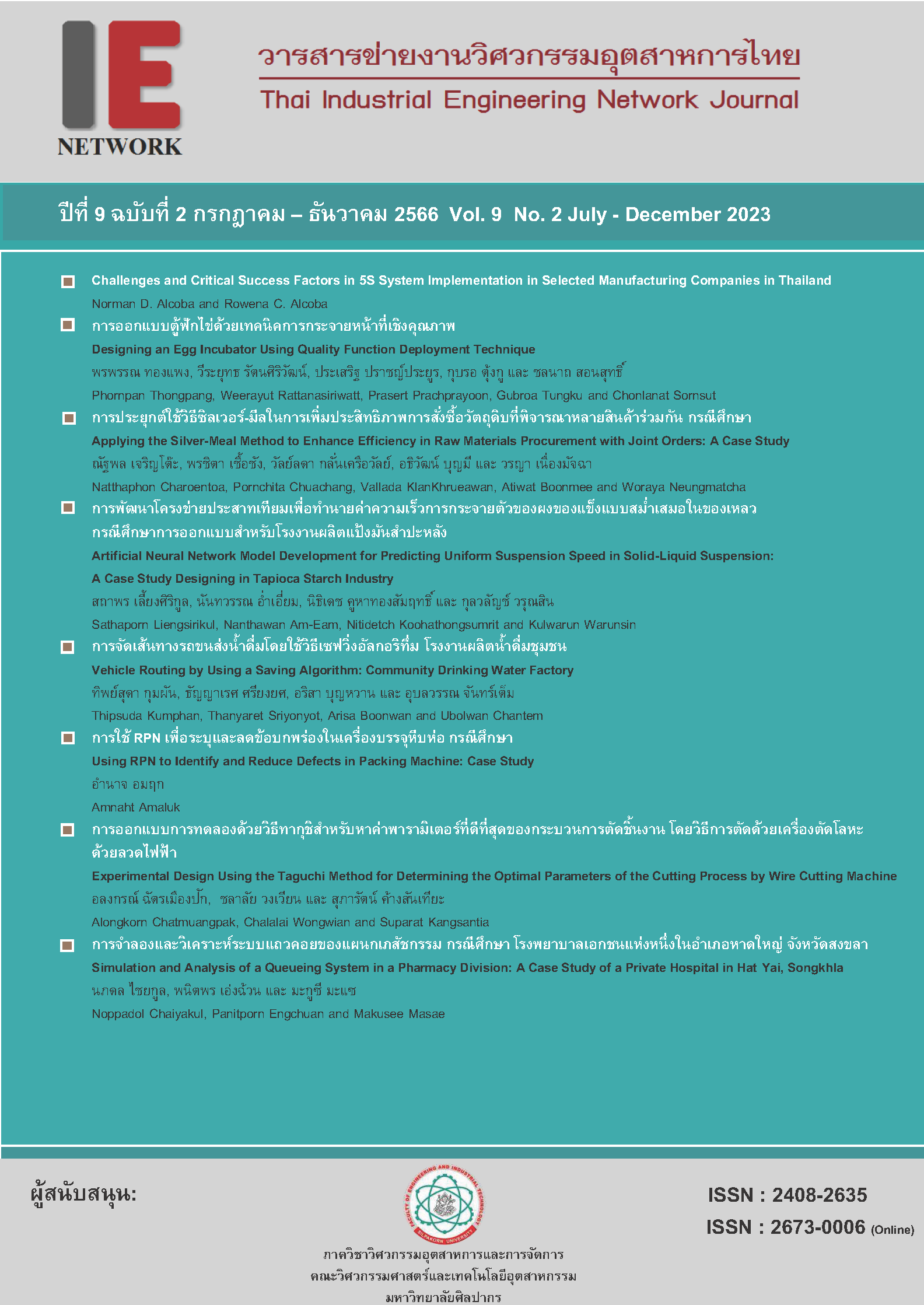Using RPN to Identify and Reduce Defects in Packing Machine: Case Study
Main Article Content
Abstract
This research aims to examine and control the factors affecting the overall efficiency of horizontal packaging machines. The study focuses on the KM1200 RB horizontal packaging machine and applies principles of overall machine efficiency. It involves analyzing defects and their impact and addressing identified issues to enhance the efficiency of the horizontal packaging machine. The current machine operates at 77.30% efficiency. Data analysis revealed that the main problems are blade wear on the End Cutter Sealer, broken notches that secure the sealing face, and cracked sealing faces, all stemming from the inability of the End Cutter Sealer to cut the pouches. To address these issues, two main improvements were implemented. Firstly, recommendations and knowledge sharing about blade maintenance for the End Cutter Sealer were introduced. Secondly, a self-maintenance plan was enhanced to check the blade level and provide knowledge to employees about blade maintenance. After these improvements, the efficiency of the horizontal packaging machine increased to 82.32%, indicating a 5.02% improvement in machine efficiency. This discovery provides valuable insights into enhancing the efficiency of horizontal packaging machines and highlights the effectiveness of defect analysis and impact assessment in identifying critical factors affecting machine efficiency.
Article Details

This work is licensed under a Creative Commons Attribution-NonCommercial-NoDerivatives 4.0 International License.
บทความ ข้อมูล เนื้อหา รูปภาพ ฯลฯ ที่ได้รับการตีพิมพ์ในวารสารฯ ถือเป็นลิขสิทธิ์ของวารสารฯ หากบุคคลหรือหน่วยงานใดต้องการนำทั้งหมดหรือส่วนหนึ่งส่วนใดไปเผยแพร่ต่อหรือเพื่อกระทำการใดๆ จะได้รับอนุญาต แต่ห้ามนำไปใช้เพื่่อประโยชน์ทางธุรกิจ และห้ามดัดแปลง
References
Naol Dessalegn Dejene, Mahesh Gopal. The Hybrid Pareto Chart and FMEA methodology to Reduce Various Defects in Injection Molding Process. Solid State Technology, Vol.64 Iss.2, 2021, pp.3541-3555
Ali Görener, Kerem Toker. Quality Improvement in Manufacturing Processes to Defective Products using Pareto Analysis and FMEA. Beykent University Journal of Social Sciences, Vol.6 No.2, 2013, pp.45-62
วราธร ปัญญางาม. การจัดทาระบบการบารุงรักษาเครื่องจักรด้วยเทคนิค FMEA กรณีศึกษา กระบวนการแปรรูปเนื้อสัตว์ตัวอย่าง. วิศวสารลาดกระบัง ปีที่ 33 ฉบับที่ 4 ธันวาคม 2559 หน้า 24-31
Peter Kardosa, Patrik Lahutaa, Maria Hudakovaa. Risk Assessment Using the FMEA method in the Organization of Running Events. 14th International scientific conference on sustainable, modern and safe transport, Transportation Research Procedia, Vol. 55, 2021, Pages 1538-1546
Nedeliakova, E. Stefancova, V. Kuka, A. Innovative methodology for quality and risk management in logistics processes of transport undertaking, 18th International Scientific Conference on Business Logistics in Modern Management, Croatia, 2018, pp. 41-53
Jiam Jun-a-nun, Dumrongkiat Ratana-amornpin, Korakot Hemsathapat, Narongpon Boonsongpaisan. An Application of Failure Mode and Effect Analysis (FMEA) Technique in the Final Inspection Process of an Integrated Circuit Industry. Journal of Engineering and Technology, Vol.1 No.1, January-June 2013, pp.34-38
Sekar Vinodh and D. Santhosh. Application of FMEA to an automotive leaf spring manufacturing organization. The TQM Journal, Vol.24 No.3, 2012, pp.260-274
รัชฎากรณ์ ภู่ห้อย และ ประจวบ กล่อมจิตร. การวิเคราะห์ความเสี่ยงระดับปฏิบัติการ กรณีศึกษา โรงงานผลิตถุงพลาสติก. วารสารวิศวกรรมศาสตร์และนวัตกรรม ปีที่ 15 ฉบับที่ 4 ประจําเดือน ตุลาคม-ธันวาคม 2565 หน้า 120-128
Randula L. Hettiarachchi, Pisut Koomsap and Panarpa Ardneam. VIKOR power law-based customer-oriented FMEA with complete unique risk priority numbers. International Journal of Quality & Reliability Management, Vol. 39 No. 8, 2022, pp. 2020-2040
กิตติชัย อธิกุลรัตน์, ศิรัตน์ แจ้งรักษ์สกุล และเจษฎา พลายชุมพล. การประยุกต์รูปแบบความล้มเหลวและการวิเคราะห์ผลกระทบเพื่อลดของเสียในกระบวนการผลิตเสาไฟฟ้า. วิศวสารลาดกระบัง ปีที่ 38 ฉบับที่ 3 กันยายน 2564 หน้า 63-76


